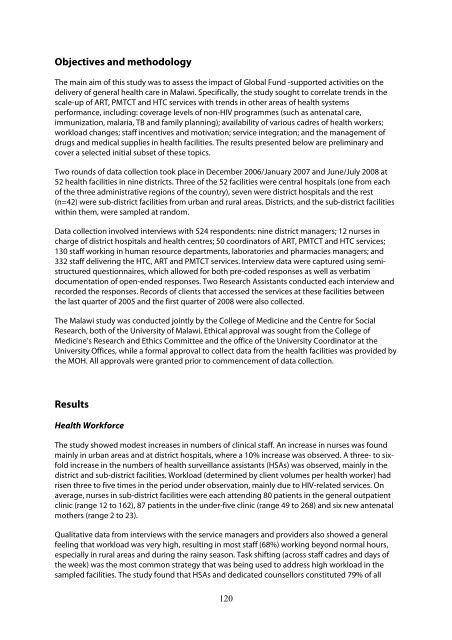MAXIMIZING POSITIVE SYNERGIES - World Health Organization
MAXIMIZING POSITIVE SYNERGIES - World Health Organization
MAXIMIZING POSITIVE SYNERGIES - World Health Organization
Create successful ePaper yourself
Turn your PDF publications into a flip-book with our unique Google optimized e-Paper software.
Objectives and methodology<br />
The main aim of this study was to assess the impact of Global Fund -supported activities on the<br />
delivery of general health care in Malawi. Specifically, the study sought to correlate trends in the<br />
scale-up of ART, PMTCT and HTC services with trends in other areas of health systems<br />
performance, including: coverage levels of non-HIV programmes (such as antenatal care,<br />
immunization, malaria, TB and family planning); availability of various cadres of health workers;<br />
workload changes; staff incentives and motivation; service integration; and the management of<br />
drugs and medical supplies in health facilities. The results presented below are preliminary and<br />
cover a selected initial subset of these topics.<br />
Two rounds of data collection took place in December 2006/January 2007 and June/July 2008 at<br />
52 health facilities in nine districts. Three of the 52 facilities were central hospitals (one from each<br />
of the three administrative regions of the country), seven were district hospitals and the rest<br />
(n=42) were sub-district facilities from urban and rural areas. Districts, and the sub-district facilities<br />
within them, were sampled at random.<br />
Data collection involved interviews with 524 respondents: nine district managers; 12 nurses in<br />
charge of district hospitals and health centres; 50 coordinators of ART, PMTCT and HTC services;<br />
130 staff working in human resource departments, laboratories and pharmacies managers; and<br />
332 staff delivering the HTC, ART and PMTCT services. Interview data were captured using semistructured<br />
questionnaires, which allowed for both pre-coded responses as well as verbatim<br />
documentation of open-ended responses. Two Research Assistants conducted each interview and<br />
recorded the responses. Records of clients that accessed the services at these facilities between<br />
the last quarter of 2005 and the first quarter of 2008 were also collected.<br />
The Malawi study was conducted jointly by the College of Medicine and the Centre for Social<br />
Research, both of the University of Malawi. Ethical approval was sought from the College of<br />
Medicine’s Research and Ethics Committee and the office of the University Coordinator at the<br />
University Offices, while a formal approval to collect data from the health facilities was provided by<br />
the MOH. All approvals were granted prior to commencement of data collection.<br />
Results<br />
<strong>Health</strong> Workforce<br />
The study showed modest increases in numbers of clinical staff. An increase in nurses was found<br />
mainly in urban areas and at district hospitals, where a 10% increase was observed. A three- to sixfold<br />
increase in the numbers of health surveillance assistants (HSAs) was observed, mainly in the<br />
district and sub-district facilities. Workload (determined by client volumes per health worker) had<br />
risen three to five times in the period under observation, mainly due to HIV-related services. On<br />
average, nurses in sub-district facilities were each attending 80 patients in the general outpatient<br />
clinic (range 12 to 162), 87 patients in the under-five clinic (range 49 to 268) and six new antenatal<br />
mothers (range 2 to 23).<br />
Qualitative data from interviews with the service managers and providers also showed a general<br />
feeling that workload was very high, resulting in most staff (68%) working beyond normal hours,<br />
especially in rural areas and during the rainy season. Task shifting (across staff cadres and days of<br />
the week) was the most common strategy that was being used to address high workload in the<br />
sampled facilities. The study found that HSAs and dedicated counsellors constituted 79% of all<br />
120

















